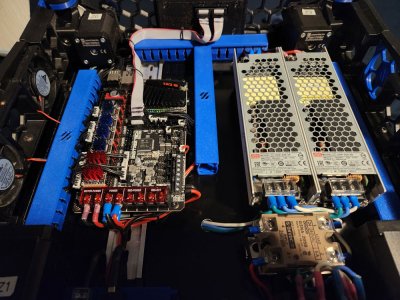Similarly, the Octopus EZ Max is extremely overkill with 10 steppers. With CAN you need fewer steppers on the mainboard, not more. I'm also not really sold on BTT's EZ step sticks since they can't be used in that many boards. Kinda the opposite of what you want in future-proofing as unless BTT explicitly releases an EZ version - you can't use any future stepper driver. The likelihood that a plain step-stick is released is much higher.
I would recommend the Manta MP8 (1.1) for a V2. This gets you CAN and you can use a Pi CM4 or CB1 and have a 1 board solution. I would suggest an SB2040 for the tool head since BTT's CAN tool head board for Stealthburner is larger/ heavier/ designed for their silly Stealthburner screen. I have 3 SB2040s (2 V2s and one on a modified Prusa) and other than explicitly needing a pullup in the config for the probe which wasn't documented that well when I was doing this the first time, I have no complaints. They are small, cheap, high quality, and have a few extra pins for expansion if needed.
5160s are entirely useless unless you want to go 48V - and really you only want this for A/B. The step-stick ones aren't that great for this - tool much risk of frying the mainboard since while an Octopus or Manta is usually built to handle 24V shorts to places it shouldn't be (ground, data pins), 48Vs is too much and breaks things. When the 5160s pop, they take out other parts of the board - I have sadly had this happen and was not happy with the amount of money needed to buy new boards and stepper drivers (the 2209s I had on the board also fried). Besides making my printer a little louder, I also didn't really see much benefit from 48V even at fairly high speed so while I have a 48V PSU, I have my A/B 5160s currently set to 24V. I do admit I like that I can go back to 48V with changing a couple of jumpers. I purchased upgraded 5160s (the new PRO 1.3 models) so maybe these are more resilient than the ones that blew. At 24V there is no real difference between 2209s and 5160s other than how they are wired and the resulting Klipper config.
There are
standalone 5160s - basically a step-stick adapter to a larger 5160 board as well as CAN options like the
DFH party in the back which is a CAN A/B motor board with two supersized 5160s, designed to mount to the extrusion between V2 motions. I personally have not tried these options, but if I was starting to get serious about 48V again, I might. If you know you are going with the DFH party in the back and SB2040, you technically can run a V2 off a Manta MP5. I would suggest
a CAN ERCF board too (the only other other reason, well that I can think of, why you wanted more stepper slots) as well.
A note on size - I have a 350 V2. 99% of the time, I am not making use of the fact it's 350mm and hence for my 2nd V2 built a 250mm one. Every now and again I do run into a project where having the added size is useful but unless you know you are going to need that, or happen to have a large amount of space for your hobbies, I would advise against it. The biggest downside besides taking up a lot more space and being heavier/ harder to move around is the 350mm printer takes a lot longer to heat up. I will admit my 350mm was easier to tune (the general feedback is actually the reverse) and is quieter (all that mass dampens vibration) than my 250mm. So not necessarily suggesting you don't go 350mm - just be aware of the pros/ cons.
Agree with clee on the Pi. Manta would take a CM4 (and you can use a breakout board to use a CM4 as a "standalone" Pi) which is overkill. I do actually really like the CB1s. The original version had some issues with WiFi, but newer ones work well. A CB1 is basically a Pi3 in CM4 form factor (although it takes a slightly different image) and more than enough for a V2 with multiple CAN accessories, webcam, etc.
I personally am not a huge fan of Klicky. I haven't really had much trouble with the stock probes other than a couple of them melting over the years. One was due to long-term wear, the other was due to a blob. They are cheap, buy some spares. With a tool head board like SB2040 it's easy to swap out if needed.


